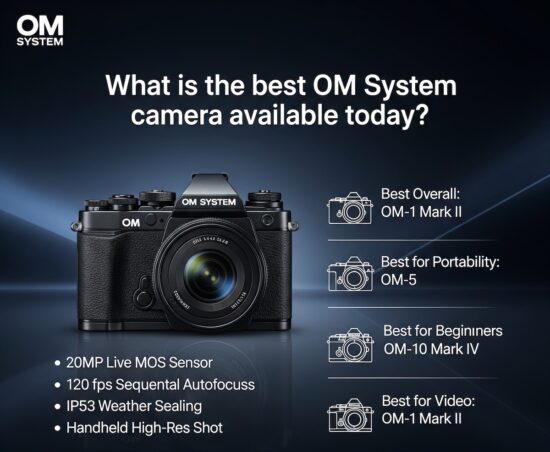
The best OM System camera available as of July 2025 is the OM System OM-1 Mark II. This flagship model stands out for its exceptional performance in wildlife, sports, macro, and landscape photography, thanks to a combination of advanced computational features, rapid burst shooting, robust weather sealing, and improved autofocus that rivals or exceeds competitors with larger sensors.
Key reasons why the OM-1 Mark II is the best OM System camera available today:
- High-Speed Performance: It features a 20MP stacked BSI Live MOS Micro Four Thirds sensor that enables burst rates up to 50fps with continuous autofocus (C-AF) or 120fps with locked AF/AE, paired with a deep buffer for over 200 raw shots in a sequence. This makes it ideal for capturing fast action, like birds in flight or sports.
- Superior Stabilization and Durability: Offers up to 8.5 stops of in-body image stabilization (IBIS) when paired with Sync-IS lenses, allowing sharp handheld shots in low light. It’s also IP53-rated for dust and splash resistance, making it reliable in harsh outdoor conditions.
- Advanced Features: Includes unique computational tools like Live Graduated ND filters for balanced exposures without physical filters, in-camera focus stacking for macro work, 80MP high-res pixel-shift mode, and subject-detection AF for humans, animals, birds, cars, and more. Video capabilities reach 4K 60p with 10-bit color.
- Battery Life and Handling: Rated for around 500 shots per charge (extendable with a battery grip), it has a pro-level build with dual card slots, a high-resolution EVF, and customizable controls.
- Priced around $2,400 body-only, it’s positioned as OM System’s top-tier option for professionals and enthusiasts. While “best” can be subjective based on needs (e.g., portability vs. power), reviews consistently rank it above other models for overall versatility and capability.
Comparison to other top OM System cameras:
| Camera Model | Key Strengths | Best For | Price (Body-Only, Approx.) | Drawbacks |
|---|---|---|---|---|
| OM System OM-1 Mark II (2024) | Flagship sensor, 120fps bursts, 8.5-stop IBIS, pro AF, computational modes like Live GND | Wildlife, sports, macro pros | $2,400 | Bulkier than compact models |
| OM System OM-5 Mark II (June 2025 release) | Compact (under 1 lb), IP53 sealing, 7.5-stop IBIS, 50MP high-res mode, improved menus and grip | Travel, adventure, beginners | $1,200 | No subject-detection AF in video, 4K limited to 30p, smaller EVF |
| OM System OM-3 (February 2025 release) | Retro styling, same stacked sensor as OM-1 II, Creative Dial for film simulations, 120fps bursts, IP53 sealing | Creative shooters, travel with style | $2,000 | Smaller EVF, no AF joystick, less ergonomic grip for long sessions |
| Olympus OM-D E-M10 Mark IV (2020, still available) | Affordable, flip-down screen for selfies, 4.5-stop IBIS, easy interface | Beginners, vloggers | $700 | Older sensor, no weather sealing, limited bursts |
The OM-5 Mark II and OM-3 are strong 2025 additions for portability and creativity, but they don’t surpass the OM-1 Mark II in raw power or pro features.
https://photorumors.com/2025/07/23/the-latest-summer-cashback-savings-offers-in-europe/